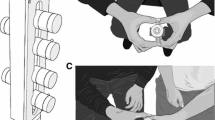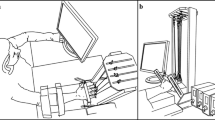Abstract
The purpose of this study was to explore the ability of the central nervous system (CNS) to organize synergies at two levels of a hypothetical control hierarchy involved in two-hand multi-finger prehension tasks with one or more persons participating in the task together. At the higher level of the hierarchy, the total force and moment of force produced on an object are distributed between the thumb and the virtual finger (an imagined finger with mechanical output equal to the involved fingers of the hand), while at the lower level the virtual finger action is distributed among the four fingers. We tested a hypothesis that the CNS is able to organize synergies at only one level of the hierarchy. The subjects held vertically one of the two handles, a narrow one and a wide one. They used the four fingers of the right hand opposed by the right hand thumb, the left hand thumb, the left hand index finger, the thumb of an experimenter, the index finger of an experimenter, or an inanimate object. Forces and moments of force produced by each digit were recorded. Indices of synergies stabilizing the mechanical output variables at each of the two levels were computed. Contrary to the expectations, force and moment of force stabilizing synergies were found at one or both levels of the hierarchy across all tasks. Unimanual tasks exhibited higher synergy indices compared to all tasks, while intrapersonal synergy indices were higher than those of interpersonal synergies. The results suggest that both feed-forward and feedback mechanisms may be used to create force and moment of force stabilizing synergies. We invoke the notion of chain effects and generalize it for relations among variance components related to stabilization of different mechanical variables. The reference configuration hypothesis offers a fruitful framework for analysis of prehension synergies.



Similar content being viewed by others
References
Arbib MA, Iberall T, Lyons D (1985) Coordinated control programs for movements of the hand. Exp Brain Res Suppl 10:111–129
Baud-Bovy G, Soechting JF (2001) Two virtual fingers in the control of the tripod grasp. J Neurophysiol 86:604–615
Bernstein NA (1947) On the construction of movements. Medgiz, Moscow (in Russian)
Bernstein NA (1967) The co-ordination and regulation of movements. Pergamon Press, Oxford
Bernstein NA (1996) On dexterity and its development. In: Latash ML, Turvey MT (eds) Dexterity and its development. Erlbaum, Mahwah
Black DP, Riley MA, McCord CK (2007) Synergies in intra and interpersonal interlimb rhythmic coordination. Motor Control 11:348–373
Boudreau MJ, Smith AM (2001) Activity in rostral motor cortex in response to predictable force-pulse perturbations in a precision grip task. J Neurophysiol 86:1079–1085
Budgeon MK, Latash ML, Zatsiorsky VM (2008) Digit force adjustments during finger addition/removal in multi-digit prehension. Exp Brain Res 189:345–359
Cesari P, Newell KM (1999) The scaling of human grip configurations. J Exp Psychol Hum Percept Perform 25:927–935
Cesari P, Newell KM (2000) Body-scaled transitions in human grip configurations. J Exp Psychol Hum Percept Perform 26:1657–1668
Charles J, Gordon AM (2006) Development of hand-arm bimanual intensive therapy (HABIT) for improving bimanual coordination in children with hemiplegic cerebral palsy. Dev Med Child Neurol 48:931–936
Danion F, Schöner G, Latash ML, Li S, Scholz JP, Zatsiorsky VM (2003) A mode hypothesis for finger interaction during multi-finger force-production tasks. Biol Cybern 88:91–98
Feldman AG (1966) Functional tuning of the nervous system with control of movement or maintenance of a steady posture––II. Controllable parameters of the muscles. Biophysics 11:565–578
Feldman AG (1986) Once more on the equilibrium point hypothesis (λ model) for motor control. J Mot Behav 18:17–54
Feldman AG, Levin MF (1995) Positional frames of reference in motor control: their origin and use. Behav Brain Sci 18:723–806
Feldman AG, Goussev V, Sangole A, Levin MF (2007) Threshold position control and the principle of minimal interaction in motor actions. Prog Brain Res 165:267–281
Flash T (1987) The control of hand equilibrium trajectories in multi-joint arm movements. Biol Cybern 57:257–274
Frietas PB Jr, Krishnan V, Jaric S (2007) Elaborate force coordination of precision grip could be generalized to bimanual grasping techniques. Neurosci Lett 412:179–184
Gao F, Latash ML, Zatsiorsky VM (2005) Control of finger force direction in the flexion-extension plane. Exp Brain Res 161:307–315
Gelfand IM, Latash ML (1998) On the problem of adequate language in motor control. Motor Control 2:306–313
Gelfand IM, Tsetlin ML (1966) Mathematical modeling of the mechanisms of the central nervous system. In: Gelfand et al (eds) Models of the structural-functional organization of certain biological systems, Nauka, Moscow, pp 1–22 (a translation is available in 1971 edition by MIT Press, Cambridge)
Goodman SR, Latash ML (2006) Feed-forward control of a redundant motor system. Biol Cybern 95:271–280
Gorniak SL, Duarte M, Latash ML (2008) Do synergies improve accuracy? A study of speed-accuracy trade-offs during finger force production. Motor Control 12:151–172
Gorniak SL, Zatsiorsky VM, Latash ML (2007a) Hierarchies of synergies: an example of two-hand, multifinger tasks. Exp Brain Res 179:167–180
Gorniak SL, Zatsiorsky VM, Latash ML (2007b) Emerging and disappearing synergies in a hierarchically controlled system. Exp Brain Res 183:259–270
Gorniak SL, Zatsiorsky VM, Latash ML (2009) Hierarchical control of static prehension I. Biomechanics. (under review, the companion paper)
Jaric S, Collins JJ, Marwaha R, Russell E (2006) Interlimb and within limb force coordination in static bimanual manipulation task. Exp Brain Res 168:88–97
Johansson RS (1996) Sensory control of dextrous manipulation in humans. In: Wing A, Haggard P, Flanagan R (eds) Hand and brain. Academic Press, San Diego, pp 381–414
Johansson RS (1998) Sensory input and control of grip. Novartis Found Symp 218:45–59 discussion 59–63
Kang N, Shinohara M, Zatsiorsky VM, Latash ML (2004) Learning multi-finger synergies: an uncontrolled manifold analysis. Exp Brain Res 157:336–350
Latash ML (1996) How does our brain make its choices? In: Latash ML, Turvey MT (eds) Dexterity and its development. Lawrence Erlbaum Assoc, Mahwah, pp 277–304
Latash ML, Scholz JP, Schoener G (2007) Toward a new theory of motor synergies. Motor Control 11:276–308
Latash ML, Shim JK, Smilga AV, Zatsiorsky V (2005) A central back-coupling hypothesis on the organization of motor synergies: a physical metaphor and a neural model. Biol Cybern 92:186–191
Loeve M (1955) Probability theory. Van Nostrand, New York
MacKenzie CL, Iberall T (1994). The grasping hand. Amsterdam
Ostry DJ, Feldman AG (2003) A critical evaluation of the force control hypothesis in motor control. Exp Brain Res 153:275–288
Pataky TC, Latash ML, Zatsiorsky VM (2004) Tangential load sharing among fingers during prehension. Ergonomics 47:876–889
Pilon J-F, De Serres SJ, Feldman AG (2007) Threshold position control of arm movement with anticipatory increase in grip force. Exp Brain Res 181:49–67
Rose DK, Winstein CJ (2004) Bimanual training after stroke: are two hands better than one? Top Stroke Rehabil 11:20–30
Schmidt RC, Carello C, Turvey MT (1990) Phase transitions and critical fluctuations in the visual coordination of rhythmic movements between people. J Exp Psychol Hum Percept Perform 16:227–247
Shapkova EY, Shapkova AL, Goodman SR, Zatsiorsky VM, Latash ML (2008) Do synergies decrease force variability? A study of single-finger and multi-finger force production. Exp Brain Res 188:411–425
Sharp WE, Newell KM (2000) Coordination of grip configurations as a function of force output. J Mot Behav 32:73–82
Shim JK, Latash ML, Zatsiorsky VM (2005a) Prehension synergies in three dimensions. J Neurophysiol 93:766–776
Shim JK, Olafsdottir H, Zatsiorsky VM, Latash ML (2005b) The emergence and disappearance of multi-digit synergies during force-production tasks. Exp Brain Res 164:260–270
Smeets JB, Brenner E (1999) A new view on grasping. Motor Control 3:237–271
Smeets JB, Brenner E (2001) Independent movements of the digits in grasping. Exp Brain Res 139:92–100
Steenbergen B, Charles J, Gordon AM (2008) Fingertip force control during bimanual object lifting in hemiplegic cerebral palsy. Exp Brain Res 186:191–201
Todorov E, Jordan MI (2002) Optimal feedback control as a theory of motor coordination. Nat Neurosci 5:1226–1235
Turvey MT (1990) Coordination. Am Psychol 45:938–953
Zatsiorsky VM, Gao F, Latash ML (2003a) Finger force vectors in multi-finger prehension. J Biomech 36:1745–1749
Zatsiorsky VM, Gao F, Latash ML (2003b) Prehension synergies: effects of object geometry and prescribed torques. Exp Brain Res 148:77–87
Zatsiorsky VM, Latash ML (2004) Prehension synergies. Exerc Sport Sci Rev 32:75–80
Zatsiorsky VM, Latash ML (2008) Prehension synergies: an overview. J Mot Behav 40:446–476
Acknowledgments
The study was in part supported by NIH grants AG-018751, NS-035032, and AR-048563. We would like to thank Elizaveta M. Latash for her assistance in data collection.
Author information
Authors and Affiliations
Corresponding author
Appendix
Appendix
Force and moment of force sharing at the VF-TH level
The equations of statics impose constraints on the forces and moments of force produced by the elements at both VF-TH and IF levels. However, the system is redundant at both levels (reviewed in Zatsiorsky and Latash 2008); hence, different magnitudes of the outputs of individual elements can be used at both levels. Only data for the virtual finger––opposing effector level are presented here; the data for the individual fingers within the VF can be found in the companion paper (Gorniak et al. 2009).
Figure 4 presents average data across subjects normal force, tangential force, and moment of total force data for the virtual finger and opposing effector across all tested conditions. Force and moment of force produced by the virtual finger are represented by white bars while opposing effector forces and moments of force are represented by gray bars. Data are presented in local frames of reference (sensor based frames of reference); note that moments produced by the virtual finger would pronate the object while moments exerted by the opposing effector would supinate the object.
The normal force (F n , panels a and b), tangential force (F t, panels c and d), and total moment of force (M TOT, panels e and f) exerted on the handle for the narrow (panels a, c, and e) and wide (panels b, d, and f) handle widths. The data averaged across all subjects with standard error bars are shown. White bars indicate forces and moments of force produced by the virtual finger (VF) while grey bars indicate forces and moments of force produced by the opposing effector (OE). The data averaged across all subjects with standard error bars are shown. Abbreviations are the same as in Fig. 1
Panels a and b of Fig. 4 show the magnitudes of normal forces for both the narrow and wide handle widths, respectively. Note that each of the two opposing effectors produced normal forces that varied broadly across the conditions while, within each condition, the forces were nearly equal to each other in magnitude. The tangential forces produced by the two effectors (panels c and d of Fig. 4) were similar to each other in all conditions except the one-hand grasp, TR + VFR, for which VF produced significantly lower force as compared to the opposing effector. The total moment of force was not exactly zero, corresponding to a net supination moment of force as shown in panels e and f of Fig. 4. Statistical analysis revealed that total moment of force was smallest for the narrow handle and finger configurations involving two persons. This was confirmed with ANOVA-1 and ANOVA-2; main effects of Width (F 1,81 = 20.72, P < 0.001) and Finger Configuration (F 4,81 = 14.32, P < 0.001 and F 5,45 = 16.2, P < 0.001) were found, respectively. Pair-wise comparisons have shown that finger configurations TE + VFR and IE + VFR yielded the smallest overall total moment of force.
Rights and permissions
About this article
Cite this article
Gorniak, S.L., Zatsiorsky, V.M. & Latash, M.L. Hierarchical control of static prehension: II. Multi-digit synergies. Exp Brain Res 194, 1–15 (2009). https://doi.org/10.1007/s00221-008-1663-7
Received:
Accepted:
Published:
Issue Date:
DOI: https://doi.org/10.1007/s00221-008-1663-7





